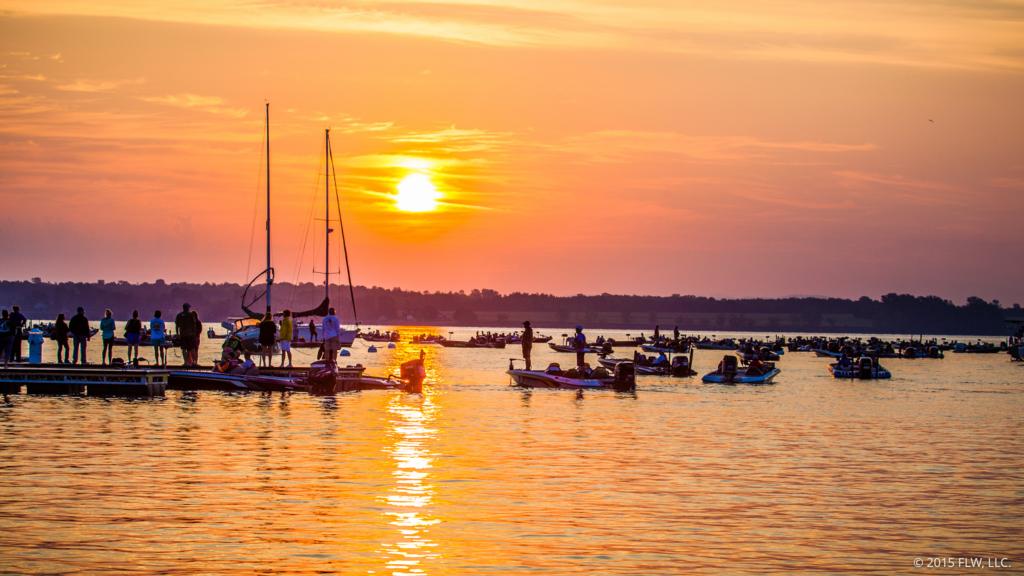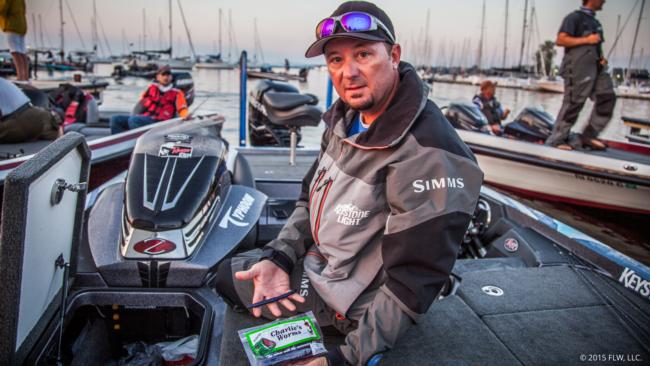North or South on Champlain?
Weather set to make an impact on day one

With waves 1 to 3 feet and thunderstorms in the offing as day one of the Rayovac FLW Series event presented by Plano gets under way on Lake Champlain, the anglers will have a tall task no matter which direction they run.
Heading South
Talk among the anglers at registration of the event, which is hosted by the City of Plattsburgh and the Adirondack Coast Visitors Bureau, was typically mixed. Though the south end of the lake is fishing a little differently from years past, a big portion of the field believes that the winning fish will be caught an hour or more south of takeoff near Ticonderoga (often shortened to Ti) where most of the fishing is focused on largemouths. Heavy winds will spell bad news for anyone making the run.
“It takes me 54 minutes to get to the bridge [the de facto entrance to the south end] in my boat with great weather,” explains Tom Lavictorie Jr., who won on Champlain in 2013. “It’ll take me two hours or more in bad weather, and you want to allow for more than that to get back.
“I haven’t quite decided, but I think I might be going to Ti all three days,” continues Lavictorie. “It depends what the wind is doing in the morning. The north is enough of a factor that if it blows I think I can do okay up here. But there’s a 98-percent chance I go down south.”
“I practiced in both places,” says Joe Wood, who has yet to record an AOY finish below 10th in the Northern Division. “It’s a tough decision. There are some big fish being caught by Ti, but there are some solid bags being caught up north. I think if you want to win it you have to roll the dice and run south. I think I’m going to roll the dice.”
Also among the crowd headed south are veterans Chad Grigsby and Glenn Browne. Both spoke to the specificity of their patterns.
“I’ve got several little deals going, all grass related,” says Browne. “I’ve got a couple sweet spots out in the grass, and a couple things that seem to be better for big fish. I’ve got one offshore spot where I was catching them every flip, and I caught about 23 pounds my last day of practice. It is different than normal, but I have one little deal that seems to be working well for big ones.”
“There are a few little areas I found that have a lot of fish,” reveals Grigsby. “I only have three or four spots, and they’re spots. You see grass for three or four miles, but for whatever reason they will all be in one little place.”
Staying North
Of course, fishing up north is absolutely an option, especially on days with rough water. If an angler chooses to fish north, he is likely to target either exclusively smallmouths or catch some smallmouths for a limit before heading to shallow cover for kicker largemouths.
“I’ve been fishing for smallmouths, but they’re pretty difficult to find,” says Rob Digh, who plans to stay northward. “They seem to be moving around a lot. I’ve caught them anywhere from 25 to 5 feet deep, and they seem to be really scattered out. I think a good day for me would be about 18 pounds with three largemouths and a couple of smallmouths.”
“I put a little time in down at Ti,” adds Troy Morrow, whose next tournament will be the Forrest Wood Cup on Lake Ouachita. “I go down every time and learn a little more, but inevitably I end up fishing for smallmouths [up north]. You’re going to catch a lot of smallmouths, and they don’t necessarily school according to size. What you’re hoping for is two really big bites in the 4- to 5-pound class, and then all 3 1/2-pounders for fillers.”
The Tactics
North or south, Champlain’s plentiful grass will hold many of the fish. Thus, jigs, soft plastics, spinnerbaits and the like will play an important role. For roaming smallmouths, jerkbaits, swimbaits and topwaters will rule the day. For smallmouths that are more hunkered down and keyed on the bottom, the northern staples of a tube and a drop-shot rig are always key.
With big decisions ahead and weather on the way, the only sure thing is that Champlain will kick out limits for nearly everyone in the field.
Conditions
Sunrise: 5:36 a.m.
Water temperature: low to upper 70s
Air temperature at launch: 70 degrees
Forecast high: 81 degrees
Wind: SW at 5 mph, switching to W at 12 to 16 mph mid-afternoon
Waves: 1 to 3 feet
Weather: clouds and sun in the morning with rain and storms in the early afternoon.
Tournament Details
Format:
All boaters and co-anglers will compete for three days. The top 10 boaters and co-anglers based on cumulative weight after two days of competition will advance to the third and final round, with the winner each division determined by the heaviest cumulative three-day weight.
Presenting sponsor: Plano
Host: City of Plattsburgh and the Adirondack Coast Visitors Bureau
Takeoff time: 6:00 a.m. ET
Takeoff location: Dock Street Landing, 5 Dock Street, Plattsburgh, NY
Weigh-in time: 2:00 p.m. ET
Weigh-in location: Dock Street Landing
More information
For complete details and updated information, visit the Rayovac FLW Series tournament page. For regular updates, photos, tournament news and more, follow the Rayovac FLW Series on Facebook at Facebook.com/FLWFishing and on Twitter atTwitter.com/FLWFishing.
